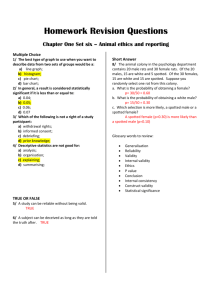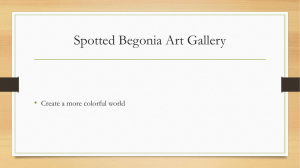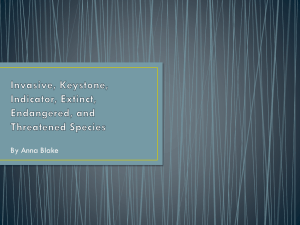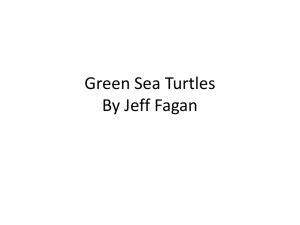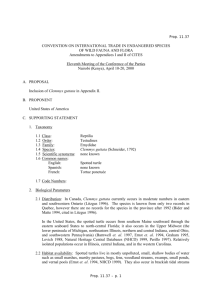Spotted Turtle - Endangered Species Coalition
advertisement
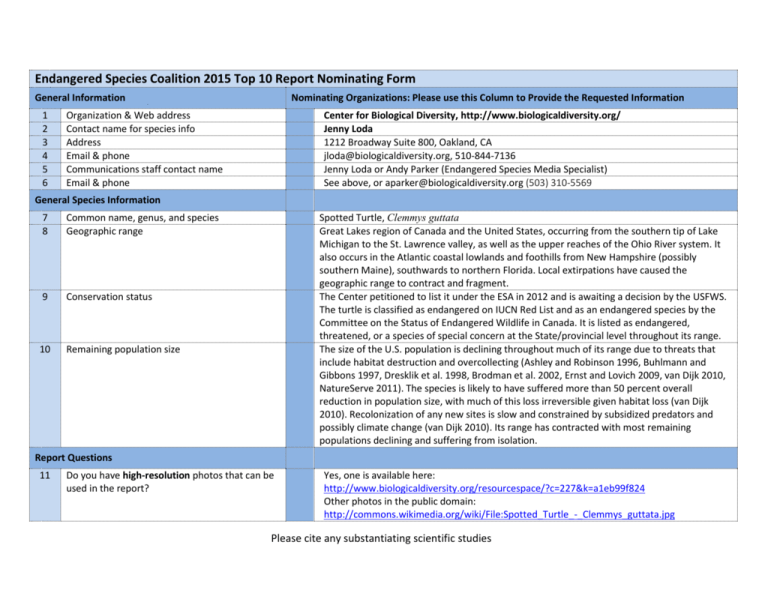
Endangered Species Coalition 2015 Top 10 Report Nominating Form General Information 1 2 3 4 5 6 Nominating Organizations: Please use this Column to Provide the Requested Information Organization & Web address Contact name for species info Address Email & phone Communications staff contact name Email & phone Center for Biological Diversity, http://www.biologicaldiversity.org/ Jenny Loda 1212 Broadway Suite 800, Oakland, CA jloda@biologicaldiversity.org, 510-844-7136 Jenny Loda or Andy Parker (Endangered Species Media Specialist) See above, or aparker@biologicaldiversity.org (503) 310-5569 General Species Information 7 8 Common name, genus, and species Geographic range 9 Conservation status 10 Remaining population size Spotted Turtle, Clemmys guttata Great Lakes region of Canada and the United States, occurring from the southern tip of Lake Michigan to the St. Lawrence valley, as well as the upper reaches of the Ohio River system. It also occurs in the Atlantic coastal lowlands and foothills from New Hampshire (possibly southern Maine), southwards to northern Florida. Local extirpations have caused the geographic range to contract and fragment. The Center petitioned to list it under the ESA in 2012 and is awaiting a decision by the USFWS. The turtle is classified as endangered on IUCN Red List and as an endangered species by the Committee on the Status of Endangered Wildlife in Canada. It is listed as endangered, threatened, or a species of special concern at the State/provincial level throughout its range. The size of the U.S. population is declining throughout much of its range due to threats that include habitat destruction and overcollecting (Ashley and Robinson 1996, Buhlmann and Gibbons 1997, Dresklik et al. 1998, Brodman et al. 2002, Ernst and Lovich 2009, van Dijk 2010, NatureServe 2011). The species is likely to have suffered more than 50 percent overall reduction in population size, with much of this loss irreversible given habitat loss (van Dijk 2010). Recolonization of any new sites is slow and constrained by subsidized predators and possibly climate change (van Dijk 2010). Its range has contracted with most remaining populations declining and suffering from isolation. Report Questions 11 Do you have high-resolution photos that can be used in the report? Yes, one is available here: http://www.biologicaldiversity.org/resourcespace/?c=227&k=a1eb99f824 Other photos in the public domain: http://commons.wikimedia.org/wiki/File:Spotted_Turtle_-_Clemmys_guttata.jpg Please cite any substantiating scientific studies 12 13 Will you want printed reports? If so, how many? If your species is selected, will you use the report as a tool to organize around the species and/or publicize its plight? Yes, Yes, we will use this as part of our campaign to stop the amphibian and reptile extinction crisis and in conjunction with our work to protect the spotted turtle, i.e. litigation and publicity around our listing petition. Public Engagement Questions (Please explain why the species is interesting, why it matters, why decision-makers + the public should care.)0 14 Interesting facts about the species 15 Additional background information to complete the species profile in the report 16 What are the most important messages that should be communicated about this species' decline? Please be sure to indicate your organization’s lead message that you would like to be included in the report. 17 Is your NGO working to save the species? If yes, how? (Optional) The spotted turtle is small, black turtle with yellow spots on its smooth shell — an attractive animal that’s an unfortunate favorite in the pet trade. Spotted turtles spend the winter hibernating, usually in communal hibernacula, in the muddy bottoms of waterways or bogs. The spotted turtle occupies a wide variety of shallow wetland habitats across its range and during the year (Joyal et al. 2001). Habitat requirements include clear, clean water; a soft substrate; and aquatic or emergent vegetation (Ernst and Lovich 2009, p. 214). In some parts of the range and during certain times of the year, it spends considerable time on land (Ward et al. 1976, Milam and Melvin 2001). They often bask along the water’s edge, on brush piles in water, or on logs or vegetation clumps (NatureServe 2011). The spotted turtle has population dynamics that emphasize the long-term reproductive contributions of adult animals over time. It occurs at low density, has an unusually low reproductive potential, and a long-lived life history (COSEWIC 2009). The age of sexual maturity is probably more closely related to reaching a specific size than age, although this length is usually obtained by 10 years of age (Ernst 1975). The maximum life span of adults is at least 26 years but may be as high as 50 (Tyning 1990). Although the spotted turtle is widespread and used to be the most common turtle species in some areas, it has likely suffered more than 50 percent overall reduction in population size due primarily to habitat destruction and fragmentation and the pet trade. Additionally, the complex movement ecology and habitat requirements of spotted turtles make their populations especially vulnerable to road mortality: over the course of a year, they typically visit multiple wetlands to forage, mate, thermoregulate, and overwinter (Joyal et al. 2001, Grgurovic and Sievert 2005), requiring frequent overland migrations and road crossings. Yes, we petitioned to list it under the ESA in 2012 and in 2014 filed a notice of intent to sue the FWS for failure to determine whether the species warrants consideration for protection under the ESA. (http://www.biologicaldiversity.org/news/center/articles/2014/usa-today-12-102014.html ) In response to a petition filed by the Center in 2011 the FWS proposed to add the spotted turtle to CITES Appendix II at CoP16 and the countries voted to adopt the proposal. Please cite any substantiating scientific studies 18 How can individuals help? Please be as specific as possible. 19 Is there anything else that governments or others could/should/are doing to save the species? (http://www.biologicaldiversity.org/news/press_releases/2013/freshwater-turtles-03-082013.html) Individuals can support the Center's campaign to get the spotted turtle listed under the ESA by writing supportive comments to the FWS when listing is proposed. Individuals can also help the species by not collecting them as pets and by watching out for them on roads. The U.S. government should protect the spotted turtle under the Endangered Species Act and work towards its recovery. Local governments should consider the turtles when planning new roads and should consider signage and lower speed limits on current key roads, in order to avoid isolating spotted turtles or creating a hazard of mortality for turtles crossing roads. Criteria-specific Questions – Please feel free to answer N/A or “see above/below” as appropriate. Please cite any substantiating scientific studies. 20 Describe the specific threat(s) to the species. 21 Why is it in need of greater connectivity? 22 Is its geographic range shifting? Many populations have been documented as in decline through loss of adults or lack of recruitment (Meylan 2006, Ernst and Lovich 2009). Its range has contracted with most remaining populations declining and suffering from isolation. The species faces ongoing threats such as habitat destruction, introduction of invasive plant species, collection for the pet trade, and mortality from vehicular encounters (Ernst and Lovich 2009, p. 221; van Dijk 2010). Habitat alteration and fragmentation is a major threat to the spotted turtle (NatureServe 2011). The species is reasonably specialized in its habitat requirements and is not a good disperser. As a result, habitat destruction and fragmentation leads to disappearance of populations (van Dijk 2010). Turtle populations in areas with heavy development likely have suffered the greatest declines in number. The complex movement ecology and habitat requirements of spotted turtles make their populations especially vulnerable to road mortality: over the course of a year, they typically visit multiple wetlands to forage, mate, thermoregulate, and overwinter (Joyal et al. 2001, Grgurovic and Sievert 2005), requiring frequent overland migrations and road crossings. Legal and illegal commercial exploitation (for both domestic use and export) and incidental collecting have impacted and continue to impact spotted turtle populations in many parts of the species’ range (Smith et al. 1973, Minton et al. 1982, Hunter et al. 1992, COSEWIC 2009, NatureServe 2011). Populations are small and fragmented and the bogs and marshes spotted turtles inhabit are also fragmented and disappearing. They are also in need of greater connectivity to reduce road mortality. Yes, local extirpations have caused the geographic range to contract and fragment. For Please cite any substantiating scientific studies 23 Is there concern around the cyclical/seasonal life of the species and its interactions within ecosystems? 24 Does it have isolated populations? 25 Is it at risk of low genetic diversity? 26 How urgent is the need for greater connectivity in order to conserve this species? Does it face a current, imminent, or future threat? 27 Indicate if there is an associated political threat. For instance, is this species being actively attacked by an industry group or member of Congress? Judge’s Score for Severity and Extent of Threat: 28 29 example, the spotted turtle’s historic range in Illinois likely included much of the Chicago metropolitan area (Cook Co.), but no individuals have been discovered in Cook County since the early 1950s (Dreslik et al. 1998). In Maine, the species has disappeared from historic range in southern Cumberland Co. (USFWS 2000). The spotted turtle relies on both wetland and terrestrial ecosystems. The bogs and marshes spotted turtles inhabit are fragmented and disappearing. Spotted turtles tend to inhabit shallow wetlands which my dry up with global warming. The species nests in upland habitats, which may be outside of the typical buffers protected around wetlands. Seasonal movements create risks for mortality on roads and from agricultural machinery, as well as a risk of illegal collection. Yes, many remaining spotted turtle populations are isolated in habitat fragments. The spotted turtle generally occurs in small localized populations (van Dijk 2010). Parker and Whiteman (1993) found that spotted turtles drawn from a small isolated wetland were significantly less diverse at these loci that those from a large wetland complex. Lack of gene flow, due to small isolated populations, may cause loss of genetic variability due to random genetic drift (Wright 1931) and inbreeding depression may occur (Franklin 1980). It is unclear how imminent the threat is as serious declines easily go unnoticed because adult turtles can live many decades after recruitment problems start, thereby masking impending local extinctions with their presence (Klemens 2000). Many likely have a low probability of persistence, especially because small numbers and isolation reduce population viability. N/A 3 Detail information on any social or economic benefits the species provides—e.g., its value for recreation or as a subject of scientific research. (Optional) Detail the ecological importance of the species (e.g., is it a keystone species?). See below The spotted turtle shares its wetland and upland habitats with numerous other species and protection of these habitats for the spotted turtle will also serve to benefit these other species. Because spotted turtles are a small species of turtle they (and their eggs) can be an important prey item for many species, in addition to spotted turtles acting as consumers/predators of a Please cite any substantiating scientific studies 30 Describe how the species could be considered an "ambassador" or “flagship” species to enlist public support for conservation. 0 variety of plants and animals. Turtles also contribute to nutrient cycling in aquatic ecosytems, as well as movement of nutrients between aquatic and terrestrial habitats. The spotted turtle is a species easily recognized by the distinctive yellow to orange spotting on its smooth, brownish-black upper shell. While its attractiveness has had the unfortunate effect of causing it to be overharvested in the past, now that it is protected from collecting in most areas it can serve as an attractive ambassador for conservation. It can serve as a flagship species for campaigning for protection of wetland/upland complexes since it relies on both habitats. Judge’s Score for Importance of Species Judge’s Final Score Please submit to top10@endangered.org, and thank you for participating in the 2015 Top 10 Report. Please cite any substantiating scientific studies
